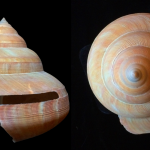![]() Why don’t animal’s use wheels in locomotion? Why aren’t blue whales bigger? Why are there no freshwater starfish? Why are there no tree dwelling cephalopods? Why can’t my dog make a decent cocktail? These are the kinds of questions that intrigue me. Apparently I am not alone.
Why don’t animal’s use wheels in locomotion? Why aren’t blue whales bigger? Why are there no freshwater starfish? Why are there no tree dwelling cephalopods? Why can’t my dog make a decent cocktail? These are the kinds of questions that intrigue me. Apparently I am not alone.
Geerat Vermeij’s new paper “Sound reasons for silence: why do molluscs not communicate acoustically?” is a thought exercise on the adaptive possibilities of life. The deliberate production of sound for communication is known in arthropods and vertebrates. But why not in the over 100,000 species of mollusks ranging 11 orders of magnitude in size that occupy just about every niche on earth from marine parasites on sea cumbers to tree dwellers?
For a new adaptive trait to appear first the appropriate genetic material or developmental infrastructure needs to be in place. Second, selection must favor the novelty.
Why would mollusks even need to produce sound? The deliberate production of sound is used to attract mates, ward of predators, locate prey, and in social communication. Of course there needs to be recipients to hear and interpret the sound. The actions of the recipient must also be predictable from the emitted sound of the producer. One of these criteria falls and sound moves from communication to noise.
Organisms that release their sperm or eggs into the water, like many molluscs, don’t need to attract a mate. On the other hand, many gastropods and cephalopods do internally fertilize so mate attraction would be important. Some of the main predators, i.e. crustaceans and vertebrates, use sound for communication and thus are able to detect sound. Yet sound detection by another major predatory group on molluscs, the echinoderms, is lacking.
Detection of sound is a mechanical ability. In the human ear, sound waves are ultimately transmitted to the cochlea where hair cells detect the mechanical movement and convert it to a chemical signal. Sound and vibration detection is known also in molluscs. On the tentacles of gastropods sensory cells can detect vibration. Cephalopods possess an equilibrium organ, the statocyst, which detects movement with the changing position of hair cells. Coquina, that colorful and tasty little bivalve common on Florida and Caribbean shores, when sensing the vibrations of coming wave will jump out of the sand to ride it. A common intertidal gastropod, the Nerite, is known to fall off boulders back into the water when humans approach.
Sound production is known in molluscs. Kitting in 1979 noted that the varying sounds produced by limpets and snails scraping algae from rocks while feeding could be used to distinguish species. The variation in sound stemmed from differences in the structure and movement of the teeth, i.e. radula. In perhaps the best example, a gastropod in Hong Kong will strike its shell against the rock when predatory snails or sea stars attack it. But it is unknown whether the sound production is intended for predator warding or simply the outcome of another anti-predator behavior, e.g. moving the shell to make predatory capture more difficult.
But if an animal produces sound it risks detection. In the animal kingdom passive defenses and defensive sound production often do not go together. An animal must back a sound up with a quick escape or the ability to confuse or resist the attacker. These are active defenses, which while common in cephalopods, are not common in other mollusks. No molluscs are the kings of ultimate passive defense…the shell. High speed escapes among molluscs like snails and bivalves are rare and most do not have the metabolism to produce athletic activity. Exceptions do exist like the scallop that can swim away, razors clams that can quickly bury themselves deeper, swimming sea slugs, and of course the cephalopods. But, those mollusks capable of fast escapes lack the raw hardware to produce sounds. They are often soft-bodied mollusks lacking a shell or air filled spaces that could produce sound. Interestingly, many of the predators of molluscs, for example sea stars, aren’t fast moving themselves.
O’ but if molluscs could acoustically communicate, who would be the prime candidates? Vermeij suggest that molluscs with co-optable structures are the cephalopods with their beaks and quick movements. But a snail contender is also present. With internal fertilization, a shell, and operculum (the little calcareous shell door that many snails have), some of the quicker moving predatory gastropods might be having whole conversations we don’t know about.
Christopher L. Kitting (1979). The use of feeding noises to determine the algal foods being consumed by individual intertidal molluscs Oecologia, 40, 1-17 DOI: 10.1007/BF00388806
Geerat J. Vermeij (2010). Sound reasons for silence: why do molluscs not communicate acoustically? Biological Journal of the Linnean Society, 100, 485-493 DOI: 10.1111/j.1095-8312.2010.01443.x






Regarding sound detection in cephalopods, I always have to point at Moynihan’s “Why are Cephalopods Deaf?” (The American Naturalist Vol. 125, No. 3, Mar 1985) in which he argues that the sophisticated visual communication system of cephalopods provides all the benefits you’d expect from acoustic communication, rendering hearing unnecessary, then goes on to suggest that deafness is actually selected for, as protection from the physically damaging sounds that can be produced by hunting cetaceans. The follow-up, of course, is Hanlon’s “Why Cephalopods are Probably Not Deaf” (The American Naturalist
Vol. 129, No. 2, Feb 1987) in which he summarizes the evidence that cephalopods can, in fact, detect and respond to underwater vibration…